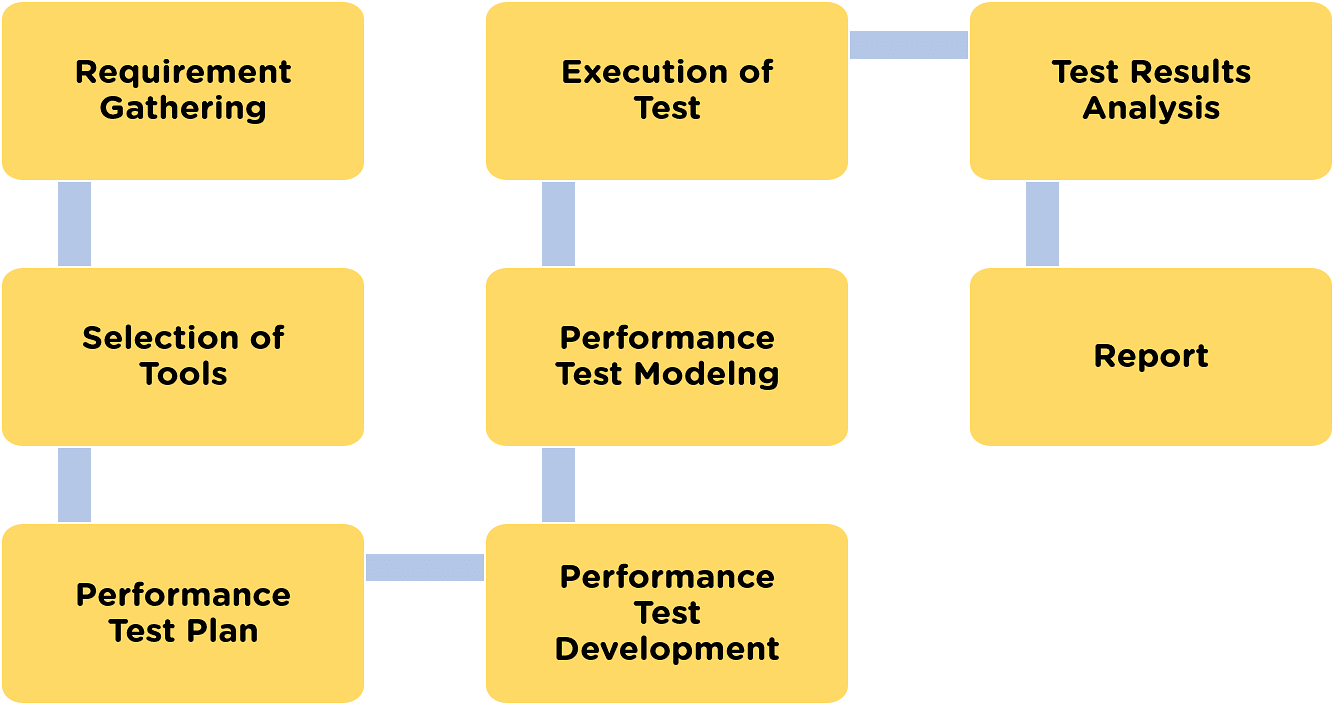Performance testing is one of the most critical phases of any product launch to verify and validate the product performance. It refers to testing a program or software under some specific workload and monitoring how it responds. It checks if the application performs as expected under that load, or if it does something unexpected.
It performs performance testing to test the speed, reliability, response time, and resource usage. The goal behind performance testing is to identify and eliminate any potential resistances to the software application.
Performance testing mainly focuses on three factors of a Software Program:
- Speed – If the response of the application is fast or not
- Scalability – The maximum user load is determined
- Stability – The application is checked under varying loads
Why Performance Testing?
Performance testing is used to identify and eliminate the performance bottlenecks in the software application. The testing eliminates performance glitches instead of finding bugs.
Performance testing enables stakeholders to have an idea about the application’s stability, scalability, and speed. The testing brings forward the issues that need fixing before the application reaches the market.
Types of Performance Testing
There are six types of performance testing, namely:
1. Load Testing
- Load testing is a type in which it tests an application for its performance at normal and peak usage.
- The performance is checked as per the response time and consistency on different user loads.
2. Volume Testing
- Volume testing is a type where the system’s performance is checked concerning the volume of data.
- To perform the test, it enters a vast amount of data into the database.
3. Stress Testing
- Stress testing is a type in which different ways to break the system are found, i.e., how much load a system can sustain.
- It checks how much load a system can hold in an incremental approach.
4. Capacity Testing
- Capacity testing is a type in which it checks an application for its capability to meet business volumes.
- The testing is performed, keeping in mind the prospects of an application and the number of users.
5. Reliability Testing
- Reliability testing is when the application is verified if the application would become normal again after an abnormal state.
- It estimates the time that the system would take to return to its normal state.
6. Scalability Testing
- Scalability testing is a type where the application is determined if it could scale up whenever needed.
- The need for scaling up comes when there is an increase in user load.
Performance Testing Process
The process of performance testing is divided into the following eight parts:

1. Requirement Gathering
- The requirements are identified and gathered from the clients.
- The information on the application’s infrastructure, functionality, and usage is gathered.
2. Selection of Tools
- After the analysis is complete, it performs proof of concept with the available tools.
- The available tools list depends on the tool cost and the technology used.
3. Performance Test Plan
- After the above steps, test planning and designing are done.
- It is the test plan that decides how the performance test will take place.
4. Performance Test Development
- Here, the use cases for the identified functionalities are created.
- Once the clients approve the use case, the script development begins.
- These scripts are then validated, and parallelly the test environment is set up.
5. Performance Test Modeling
- Here the performance load model is created for test execution.
- It is checked if they achieve the performance metrics provided by the clients.
6. Execution of Test
- Initially, the tests are not executed with maximum users that are in the Load model.
- It does the text execution in incremental order.
7. Test Results Analysis
- Results are the most important deliverable for performance testing.
- Here, the ROI and productivity that performance testing may provide are shown.
8. Report
- At the end of all the steps, it is necessary to have a simplified conclusion
- A brief, descriptive, and to-the-point test report is made.
Performance Testing Metrics
Performance Testing Metric is something that is required to understand the quality and productivity of performance testing.
Several performance testing metrics are used; some of them are:
- Processor Usage: Time spent by the processor to execute non-idle threads.
- Memory use: The available physical memory to process on a system.
- Disk time: It is the time taken by the disk to read or write a request.
- Bandwidth: Bits per second used by a network interface.
- Private bytes: A specific number of bytes allocated to a particular process.
- Committed memory: The amount of virtual memory used.
- Response time: Time between the user’s request and the first response character.
- Throughput: Rate of requests received per second by a network.
- Hit ratios: Number of SQL statements that are handled by cached data.
- Top waits: Monitoring of the wait times that could be cut.
- CPU interrupts per second: Average number of interruptions that a processor receives and processes each second.
- Maximum active sessions: Maximum number of sessions that may stay active at once.
- Thread counts: Determining the well-being of the application by checking the number of running and active threads.
- Disk queue length: Average number of read and write requests that are queued for a sample interview.
- Garbage collection: Returning the memory to the unused system, which helps in monitoring the efficiency.
Tools for Performance Testing
Some of the most popular Performance Testing tools in the market are:

JMeter
JMeter also known as ‘Apache JMeter’ is an open source, 100% java based application with a graphical interface. It is designed to analyze and measure the performance and load functional behavior of web application and variety of services.
JMeter is mainly used for testing Web application or FTP application but currently, it is applicable in functional testing, JDBC database connections, Web services, generic TCP connections and OS native processes. You can perform various testing activities like Performance, Load, Stress, Regression and Functional testing, in order to get accurate performance metrics against your web server.
JMeter was originally written and developed by Stefano Mazzocchi of the Apache Software Foundation. It was primarily written to test the performance of Apache JServ(currently known as Apache Tomcat project).Apache redesigned JMeter to enhance the GUI, to add more features and functional testing capabilities.
JMeter is not a browser and it doesn’t render html pages like any browser does, rather it works on protocol level.
Following is a list of protocols supported by JMeter:
- Web Services – SOAP / XML-RPC
- Web – HTTP, HTTPS sites ‘web 1.0’ web 2.0 (ajax, flex and flex-ws-amf)
- Database via JDBC drivers
- Directory – LDAP
- Messaging oriented service via JMS
- Service – POP3, IMAP, SMTP
A web server carries a lot number of applications and users, so it is necessary to know that how capable a web server is to handle simultaneous users or applications.
JMeter Features
Some of the most important features of JMeter are listed below:
- Open source application: JMeter is a free open source application which facilitates users or developers to use the source code for development of other applications.
- User-friendly GUI: JMeter comes with simple and interactive GUI.
- Support various testing approach: JMeter supports various testing approach like Load Testing, Distributed Testing, and Functional Testing, etc.
- Platform independent: JMeter is written and developed using java, so it can run on any environment / workstation that accepts a Java virtual machine, for example – Windows, Linux, Mac, etc.
- Support various server types: JMeter is highly extensible and capable to load the performance test in different server types:
- Support multi-protocol: JMeter supports protocols such as HTTP, JDBC, LDAP, SOAP, JMS, and FTP.
- Simulation: JMeter can simulate multiple users by using virtual users or unique users in order to generate heavy load against web application under test.
- Framework: JMeter is a multi-threading framework which allows concurrent and simultaneous sampling of different functions by many or separate thread groups.
- Remote distributed testing: JMeter has Master-Slave concept for distributed testing where master will distribute tests among all slaves and slaves will execute scripts against your server.
- Test result visualization: Test results can be viewed in different formats like graph, table, tree, and report etc.